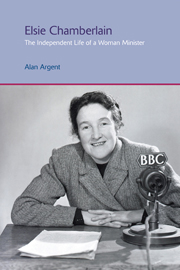Book contents
- Frontmatter
- Dedication
- Contents
- List of Illustrations
- Acknowledgements
- 1 Introduction and Early Life
- 2 The Call to the Ministry
- 3 Elsie Begins Her Ministry, 1939
- 4 The Return to London, 1941
- 5 Flying into the Storms: Chaplain in the Royal Air Force, 1945
- 6 A Season of Clear Shining: Married Life
- 7 Vineyard Congregational Church, Richmond-upon-Thames
- 8 Later Years at Vineyard
- 9 International Meetings and the CUEW Chair
- 10 Elsie at the BBC
- 11 After the BBC: The City Temple
- 12 The Sky Turns Black: Another Crisis
- 13 Sometimes a Light Surprises: The Congregational Federation
- 14 Hutton Free Church, 1971
- 15 A Local Thunderstorm: The Kentish Town Situation
- 16 Presidential Duties and Travelling, 1973–1980
- 17 Going West, 1980
- 18 Ministry in Nottingham, 1984–1991
- 19 Epilogue
- Bibliography
- Index
7 - Vineyard Congregational Church, Richmond-upon-Thames
- Frontmatter
- Dedication
- Contents
- List of Illustrations
- Acknowledgements
- 1 Introduction and Early Life
- 2 The Call to the Ministry
- 3 Elsie Begins Her Ministry, 1939
- 4 The Return to London, 1941
- 5 Flying into the Storms: Chaplain in the Royal Air Force, 1945
- 6 A Season of Clear Shining: Married Life
- 7 Vineyard Congregational Church, Richmond-upon-Thames
- 8 Later Years at Vineyard
- 9 International Meetings and the CUEW Chair
- 10 Elsie at the BBC
- 11 After the BBC: The City Temple
- 12 The Sky Turns Black: Another Crisis
- 13 Sometimes a Light Surprises: The Congregational Federation
- 14 Hutton Free Church, 1971
- 15 A Local Thunderstorm: The Kentish Town Situation
- 16 Presidential Duties and Travelling, 1973–1980
- 17 Going West, 1980
- 18 Ministry in Nottingham, 1984–1991
- 19 Epilogue
- Bibliography
- Index
Summary
Vineyard Congregational Church at Richmond-upon-Thames had been founded in 1830 and the handsome, grey brick building, designed by John Davies, opened a year later. It is sited adjacent to a Roman Catholic church, dedicated to St Elizabeth, in a side road off Hill Rise, called The Vineyard. The Catholic church had itself been opened for worship, only a few years before its neighbour, in 1824. Both churches, therefore, bear witness to the expansion of the local population at the beginning of the nineteenth century in this part of what was then rural Surrey, but which was close to the heart of the capital city. Only a few years later, with the coming of the railways, Richmond would find itself even more accessible to London.
The Vineyard Congregational Church had been unsuccessful in its attempts to find a minister early in 1947. Elsie's immediate predecessor as minister had been Edward Tait Kirby (1871–1972) who had left New College, London in 1900 and had pastorates in Southport, Whetstone, Havant, and Egham Hill from which he had formally retired in 1940. However, after this retirement, he fulfilled a part-time ministry, first at West Kensington 1940–1941 and then at the Vineyard, Richmond 1942–1946, following the resignation of the young Welsh theologian, Daniel T. Jenkins (1914–2002), whose brief but scholarly ministry at Richmond had lasted from 1940–1942, when he had accepted a post with the Student Christian Movement.
- Type
- Chapter
- Information
- Elsie ChamberlainThe Independent Life of a Woman Minister, pp. 76 - 84Publisher: Acumen PublishingPrint publication year: 2012



